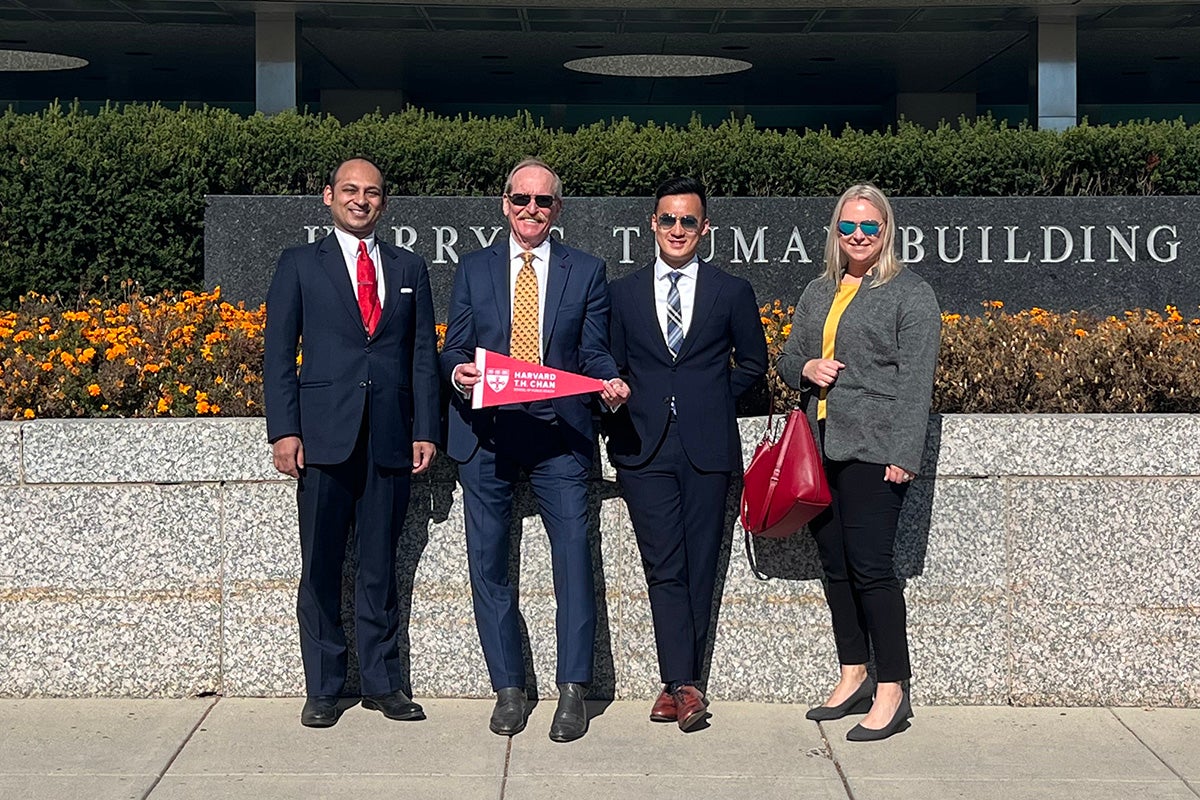Students analyze how U.S. could support allies during health emergencies

January 18, 2024 – What if there were a public health crisis facing a U.S. ally? And what if the U.S. and other governments and international organizations were called on to offer humanitarian support?
At Harvard T.H. Chan School of Public Health, three students with decades of experience in fields including data science, population health, and national security tackled these issues over the past year for a practicum project that was part of the online MPH Generalist program curriculum.
From the classroom to the capital
The students—Patrick Chen, Kasey Pomeroy, and Faisal Reza, all slated to graduate in 2024—conducted a multidisciplinary analysis of the public health risks that a U.S. ally would face during escalating crises, and then outlined recommendations for how to improve emergency preparedness and response. In early November, they traveled to Washington, D.C. to present the results of their project at several federal agencies.
The initial idea for the project was sparked by conversations between Chen, who is a senior director leading geospatial data science and population health analytics at Scripps Health, and Pomeroy, who works in national security. They were inspired by a course they took on emergency response, disasters, and public health taught by William Vanderwagen, instructor at Harvard Chan School, retired rear admiral of the U.S. Public Health Service, and former assistant secretary for preparedness and response at the U.S. Department of Health and Human Services.
“We found both of our interests to be in developing a project that had real-world impact, and something that could actually be done to help the population,” said Pomeroy.
Vanderwagen agreed to serve as the students’ practicum project advisor, and also suggested that the team should include Reza, a federal public health agency scientist who specializes in informatics, data science, and engineering.
A framework for crisis response
The team developed a framework for responding to and mitigating a public health crisis, and applied it to analyze a case study in which an ally experiences escalating crises, such as epidemics, environmental disasters, accidents, or geopolitical incidents. In those situations, there would be large numbers of people on the move and needing care in a damaged infrastructure.
The students mapped out key factors to consider in a public health emergency response, including drive times to medical facilities and distances to secure staging sites, which could be used to provide care, nourishment, and shelter if certain impacted regions of the country needed to be evacuated. They then identified strategies to help protect the population, such as setting up field hospitals and keeping supply chains clear of choke points to ensure fuel deliveries to medical facilities. They also recommended a holistic response across government agencies—including ones not normally included in emergency responses.
“There are an incredible number of factors that can come together and collectively exacerbate a public health crisis,” Chen said. “Our intention was to leverage our backgrounds in geospatial intelligence, national security, population health, and artificial intelligence to create a comprehensive framework in which our allies could mitigate the ramifications of an environmental or human-caused public health crisis.” The students’ approach and framework were designed to be universally applicable to several types of disasters, prioritizing the preservation of life and reducing human suffering.
“The students offered a methodological approach for multidisciplinary geospatial health logistics analysis that allows you to see opportunities for mitigation and reducing risk, thereby preventing more severe impacts on the health of people,” Vanderwagen said.
During the project, the students combined their different expertise to comprehensively tackle the issues. Looking at the country in the case study, Reza assessed the ability of its health system to respond to a crisis, and also assessed artificial intelligence algorithms that could help inform evacuation strategies. Additionally, Chen and Pomeroy worked together to map segments of the population likely to be affected by a crisis and formulate contingencies to keep those groups as safe as possible.
“We learned from each other. We shared our own insights. And that way, the sum became more than our individual parts,” Reza said.
Toward a real-world health impact
At the end of the project, the students and Vanderwagen were invited to present their findings to National Security Council officials at the White House and to officials at the State Department and the National Center for Disaster Medicine and Public Health, who were all interested in using the team’s analyses.
“Because of the role that the U.S. has globally—in terms of offering CDC support services or whatever role the country might have—we thought it would be important for federal officials to see the gaps that we were able to identify,” Vanderwagen said. “If they found them of significant enough concern, they could take prophylactic steps to address some of those issues, so that the U.S. government and the international community aren’t starting from scratch when the humanitarian request comes.”
– Jay Lau
Photo courtesy of Patrick Chen


